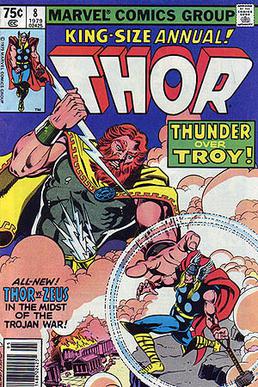
Zeus is a fictional deity, appearing in American comic books published by Marvel Comics. The character is based on the god Zeus in Greek mythology.
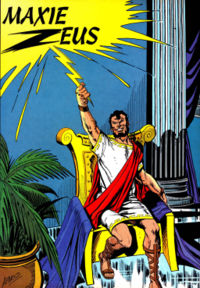
Maximilian "Maxie" Zeus is a supervillain appearing in American comic books published by DC Comics, primarily as a minor enemy of Batman. He is depicted as a mentally ill former history professor who is obsessed with Greek mythology and believes himself to be the god Zeus, becoming a crime lord in Gotham City.

The Olympians are a fictional species appearing in American comic books published by Marvel Comics. These characters are based on the Twelve Olympians/Dii Consentes and other deities of Classical mythology. During the beginning of the 1960s, the exploits of the Asgardians Thor and his evil brother Loki demonstrated that an updating of ancient myths could again win readers. In 1965, Stan Lee and Jack Kirby introduced the Olympians in Journey into Mystery Annual #1.
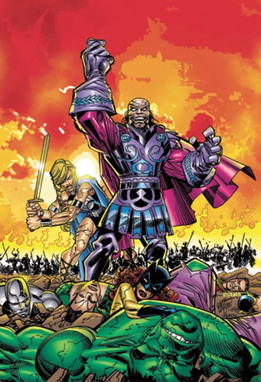
Pluto is a fictional deity appearing in American comic books published by Marvel Comics. The character is based on the Greco-Roman god of the same name.
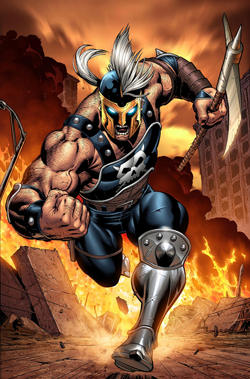
Ares is a fictional character, a deity appearing in American comic books published by Marvel Comics. The character is based on the Greek god of the same name. He first appeared in Thor #129 and was created by Stan Lee and Jack Kirby. Ares has commonly appeared as an enemy of Thor and Hercules and starred in his own self-titled series in 2006.

Ares is a character appearing in DC Comics publications and related media. Based on the eponymous Greek mythological figure, he is the Olympian god of war and major recurring adversary of the superhero Wonder Woman. He has been featured significantly as a persistent foe throughout every era of Wonder Woman's comic book adventures, and in many adaptations of her stories in other media.

Circe is a fictional character appearing in DC Comics publications and related media. Based upon the eponymous Greek mythological figure who imprisoned Odysseus in Homer's Odyssey, she is a wicked sorceress and major recurring adversary of the superhero Wonder Woman. She has been presented variously since first appearing in 1949’s Wonder Woman #37, though her characterization has consistently retained a key set of features: immortality, stunning physical beauty, a powerful command over sorcery, a penchant for turning human beings into animals and often, a delight in humiliation.
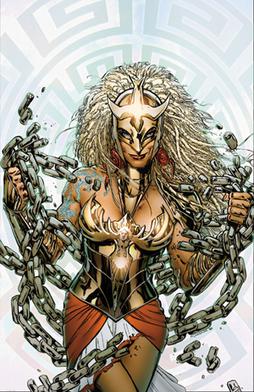
Hippolyta is a character appearing in American comic books published by Marvel Comics. Created by writer Stan Lee and artist Jack Kirby, the character first appeared in Thor #127. She is the queen of the Amazons and the daughter of Ares. Hippolyta is known under the codename Warrior Woman. She has faced the X-Men and the Fantastic Four at various points in her history.

Hercules is a fictional Olympian god in the DC Universe based on the Greek demigod and hero of the same name.
The Olympian Gods are characters based upon classical mythology who appear primarily in Wonder Woman, Captain Marvel and Aquaman comics.
Athena is a fictional deity appearing in American comic books published by Marvel Comics. She is based on the Greek Goddess of the same name.

Hera is a fictional deity appearing in American comic books published by Marvel Comics. The character is based on the Greek Goddess of the same name. Hera first appeared in the pages of Thor #129, written by Stan Lee and drawn by Jack Kirby.

Neptune, also called Poseidon, is a fictional character appearing in American comic books published by Marvel Comics. The character is based on the Roman God with the same name and his Greek counterpart. Neptune is the god of the sea in the Olympian pantheon, and the patron god of Atlantis. Neptune first appeared in Tales to Astonish #70 and was adapted by Stan Lee and Gene Colan.

Poseidon is the name of a DC Comics deity who is based on the Greek god of the same name. Due to his status as Greek god of the sea, the character has figured primarily in stories relating to two of DC Comics' main superhero properties: Wonder Woman and Aquaman.

The Children of Ares are several fictional characters appearing in DC Comics publications and related media, commonly as recurring adversaries of the superhero Wonder Woman. Primarily based on eponymous Greek mythological figures, they are malevolent progeny of Wonder Woman's nemesis, the war god Ares. Three in particular – Deimos, Phobos and Eris – have emerged as especially enduring characters, appearing in every era of Wonder Woman's comic book adventures since debuting in 1969's Wonder Woman #183. Beginning in the Silver Age of Comic Books, these three characters have often been presented as Ares’ principal legates in his campaigns for universal conquest, and have also confronted Wonder Woman on their own, individually as well as with one another, as antagonists independent of their father.
Ares has appeared frequently in modern popular culture; he usually appears as the ancient Greek god of war in the most generally familiar classical mythology.
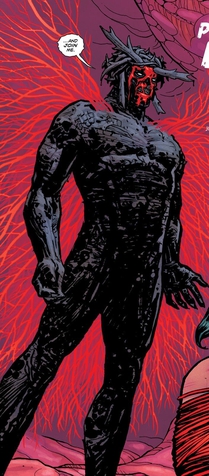
The First Born is a supervillain appearing in American comic books published by DC Comics, commonly as an adversary of the superhero Wonder Woman. Created by Brian Azzarello and Cliff Chiang, the character first appeared in Wonder Woman #13.

Zeus is a fictional deity in the DC Comics universe, an interpretation of Zeus from Greek mythology. His appearances are most significant in stories of Wonder Woman. With the 2011 relaunch of DC Comics dubbed The New 52, Zeus has received a prominent role in the Wonder Woman mythos, as he is now the biological father of Wonder Woman through Hippolyta.

The mythological Greek deity Hades often appears in popular culture. In spite of his present neutrality and lack of bad deeds, he is often portrayed as a villain due to his association with death and the underworld.
Hephaestus is the name of a fictional character appearing in American comic books published by DC Comics. He is adapted from the Greek god of the same name. Hephaestus first appeared in Wonder Woman #226.





















